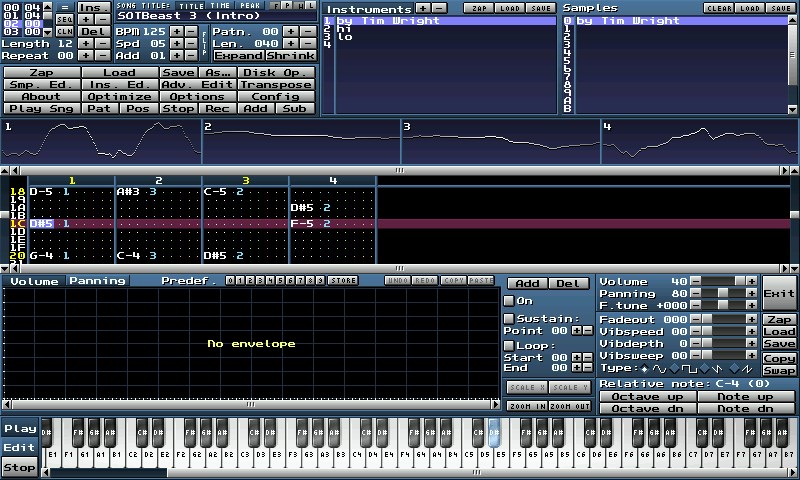

- #Milkytracker position explanation mod
- #Milkytracker position explanation update
- #Milkytracker position explanation manual
- #Milkytracker position explanation software
New!!: MilkyTracker and List of music software This is a list of notable software for creating, performing, learning, analyzing, researching, broadcasting and editing music. New!!: MilkyTracker and List of Linux audio software The following is an incomplete list of Linux audio software. New!!: MilkyTracker and Comparison of free software for audio įastTracker 2 is a music tracker created by Fredrik "Mr. This list of free software for audio lists notable free and open source software for use by sound engineers, audio producers, and those involved in sound recording and reproduction. ħ relations: Comparison of free software for audio, FastTracker 2, List of Linux audio software, List of music software, Module file, Music tracker, Scream Tracker.
#Milkytracker position explanation mod
If BPM value is 74.5412843, BPM of Song will be 110.MilkyTracker is a free software multi-platform music tracker for composing music in the MOD and XM module file formats.


If BPM value is 91.7431193, BPM of Song will be 110.Īnd if one pattern consists of 13 Rows, then Beat = 1/4 note becomes 13/4 In the case of 16 Rows in one measure, Beat = 4th note is 16/4, so In other words, the BPM value is determined as a parameter to achieve the target BPM. When setting the BPM of the actual song as 110 in Milkytracker, it is necessary to adjust the speed of one line by the BPM value or tick / row. The BPM value in MILKYTRACKER is not necessarily "BPM of how many quarter notes come out per minute" generally referred to, but it is a property value that controls the speed of one line of the pattern. This can cause problems when using trackers with other music software which may have a true BPM setting. Due to the granularity of both timer interrupts and sample speeds, the BPM value is almost never 100% accurate there is usually an error of <1BPM. Milkytracker does not use a fixed timer interrupt like the Amiga players do, instead it updates the tick value every x samples (where x is a calculated value that corresponds to the equivalent timer frequency). In America, the NTSC standard was used at 60Hz. In Europe, Amiga's were designed for the PAL TV standard which updates at 50Hz. Number of player ticks/second = BPM*2/5Ĭonverting this value to a duration is easy: Tick duration (ms) = 2500/BPM. The BPM setting defines how fast (ticks/second) the music player will run.
#Milkytracker position explanation manual
The Fasttracker II manual explains it thus: Altering the tick duration allows the BPM to be set to user defined values instead of being fixed at 125BPM, therefore the BPM setting was added. Later versions of Amiga trackers added an option to use the Amiga's CIA timer interrupt instead of the VBL, this could be programmed to different frequencies enabling the tick duration to be altered. Which coincidently, is the default BPM setting of Milkytracker We know that the standard tick duration is 20ms (for a 50Hz timer), so 24 X 20 = 480ms per beat, translating this to Beats Per Minute: Using 4 rows per beat, this equates to 4 X 6 = 24 ticks per beat. Typically this is set to 6, meaning that 6 ticks will occur for every row of a pattern.
This is where the SPD (speed) parameter comes in, this controls the number of ticks that occur before the pattern advances to the next row. Obviously this is much too fast to playback a song (50Hz = 3000bpm!) so it had to be subdivided. On the Amiga, a tick occurs at 50Hz and therefore has a duration of 20ms. This was the shortest amount of time in which these parameters could be modified and was known as a 'tick'.
#Milkytracker position explanation update
So, a player routine would use this 50Hz timer to update the values in the Amiga's sound chip (named Paula): frequency, sample address & volume. In Europe, the VBL interrupt was effectively a nice stable 50Hz timer. In ye olde days back on the Amiga, trackers used the VBL interrupt for timing (the Vertical BLank is the time in which a CRT has finished drawing the image and is resetting the beam position back to the top-left of the screen). People are often asking how these 4 are related, so I thought I'd type up a quick forum post to explain:


 0 kommentar(er)
0 kommentar(er)
